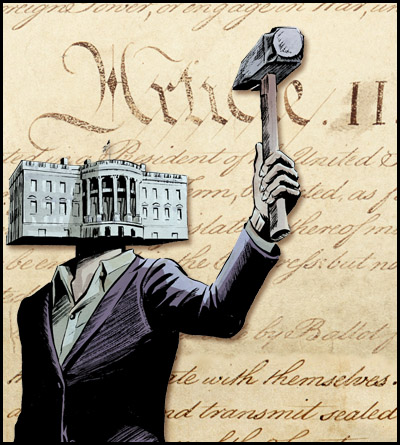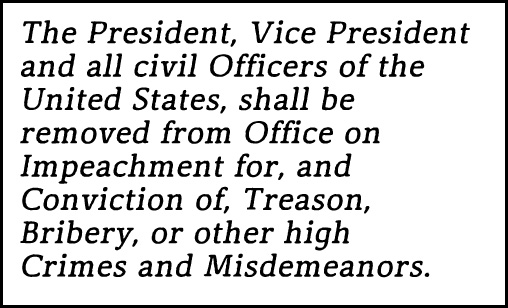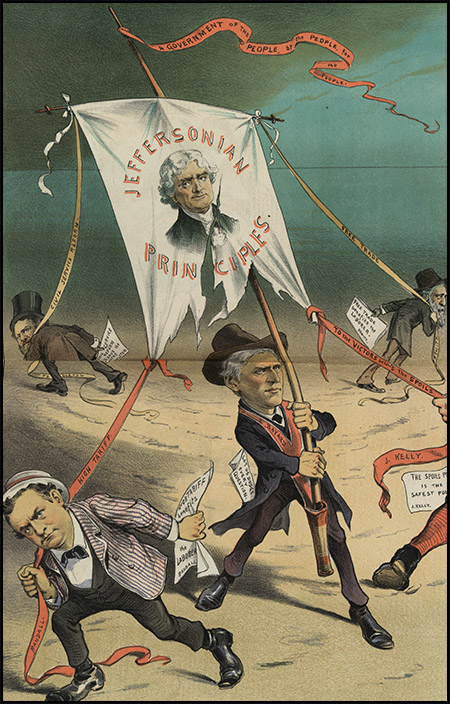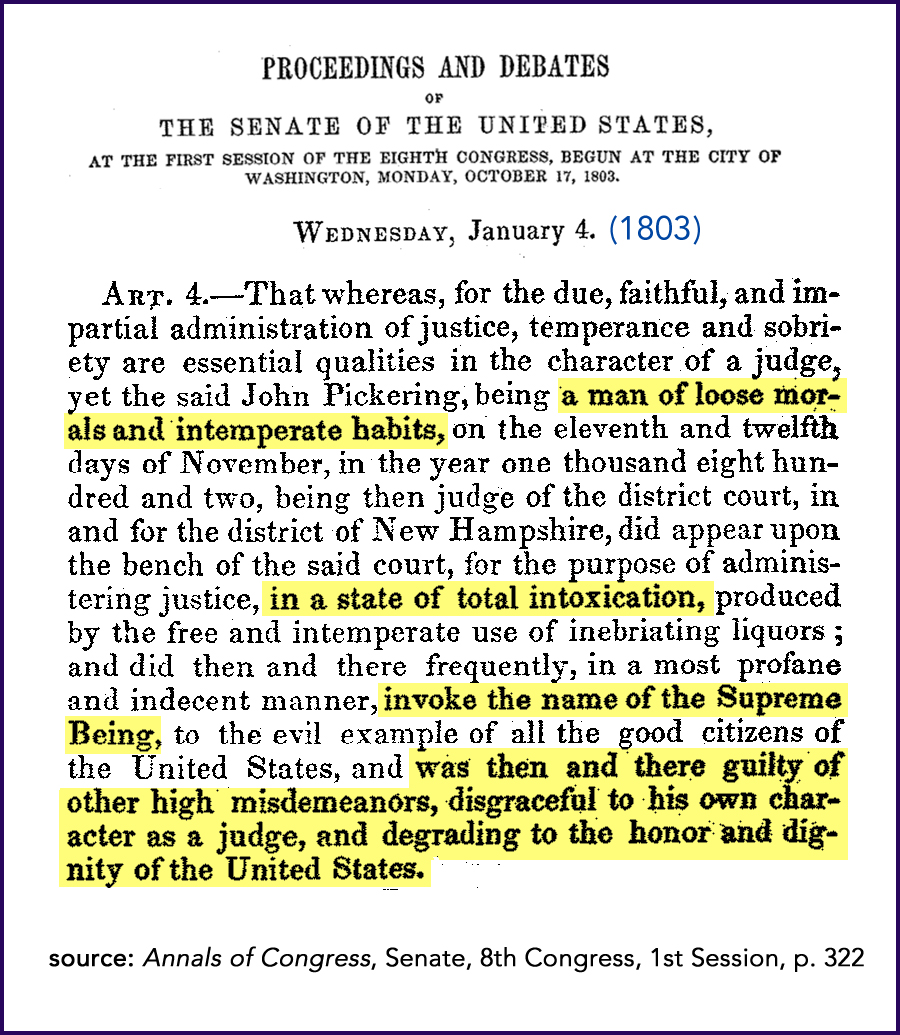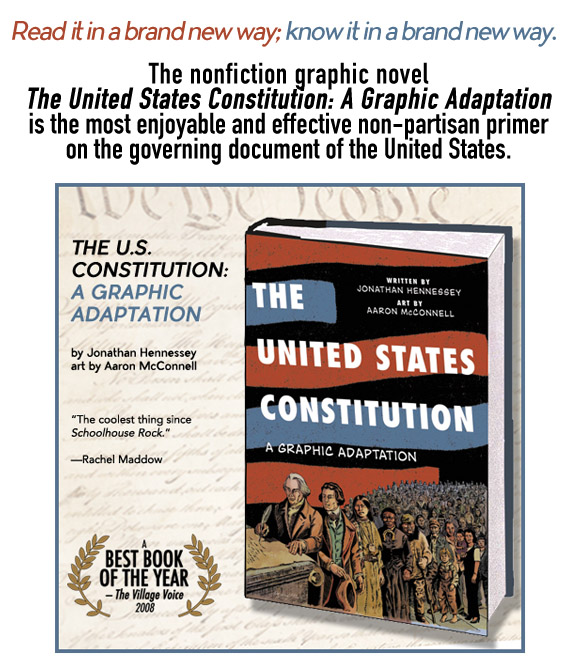We have elected a president who demonstrates a remarkable degree of apathy towards and ignorance about the United States Constitution. From his vow to “protect Article XII” (the document stops at Article VII); to his apparent belief the executive branch has the power to demand apologies from the casts of Broadway plays (especially ones whose artistic form of speech is inherently political) and to compel private companies to wish clientele “Merry Christmas”; to his disregard for the Foreign Emoluments clause; to his call for closing mosques in violation of the Free Exercise of Religion, there is little doubt that whether one approves of him or not, this country is very likely headed towards a constitutional crisis. Very plausibly a multitude of them.
Constitutional literacy, always important, is especially urgent now. It is worth everyone’s time to brush up on the supreme law of the land and be better prepared to think and speak substantively on the issues that are now before us—as well as the ones waiting just around the bend, both anticipated and unforeseen.
One topic sure to be bandied about with great alacrity over the coming years is impeachment.
(And on that note, one should immediately be reminded that “impeachment” only amounts to the go-ahead to conduct an official inquest to determine whether an accused president, vice president, or other “civil officer” should be forced from power. Impeachment, as anyone who lived through and paid attention to the Senate trial of Bill Clinton in 1999 knows, will not always be followed by conviction and removal from office.)
Let’s now take a look at the year 1803, and American history’s first impeachment. It offers particularly intriguing consequences for the present moment.
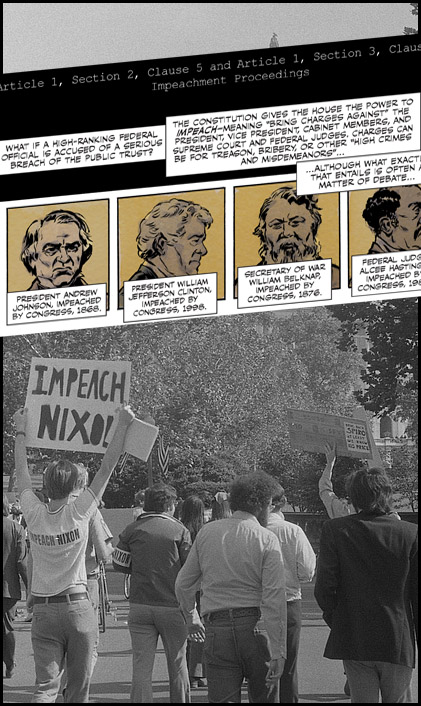 The Founding Fathers, as a rule, loathed the idea of political parties. But just a few scant decades after the American Revolution, a two-party system had developed anyway, in spite of their high-minded desires. There were the Federalists and the Democratic-Republicans.
The Founding Fathers, as a rule, loathed the idea of political parties. But just a few scant decades after the American Revolution, a two-party system had developed anyway, in spite of their high-minded desires. There were the Federalists and the Democratic-Republicans.
The Federalists were on the side of an energetic central government and a somewhat open-ended theory of the Constitution (the “implied powers doctrine” being an example of this). Federalists approved of an economy tipped in favor of industry and manufactures, a strong military (especially a navy), a modern banking and financial system, a polity geared towards only allowing men of property and virtue to exercise the vote, and the brisk collection of internal taxes to fund the government. (But remember that taxes did not include any kind of federal income or property tax, but instead consisted mostly of duties on imported goods, of which there were a lot in the low-tech days of the Early Republic, and an excise tax on distilled spirits).
The citadel of Federalism was New England. But it should be mentioned that South Carolina—especially the area around the merchant-friendly city of Charleston—was a strong outpost of Federalism. Arch-federalist Alexander Hamilton, for instance, was often gunning for South Carolina’s Charles Cotesworth Pinckney to be his party’s presidential candidate.
George Washington would never verbally commit to any party. But for all intents and purposes he was Federalist to the core. Between his first two terms as president and the administration of his successor John Adams, Federalists controlled the U.S. government for the first 12 years of nationhood.
In contrast to the Federalists, the Democratic-Republicans preferred state government authority over federal. As the original originalists, they claimed to want the Constitution given a limited, literal interpretation. Democratic-Republicans advocated for an agricultural economy. They favored the citizen militia over a professional military. They generally disdained banks and what we today call “financial instruments.” Instead of restricting the voting franchise to land owners and/or the wealthy, they pushed to allow all free white men to vote. And Democratic-Republicans had little stomach for federal taxes.
The wellspring of Democratic-Republicanism was Virginia. Its presidential triad was Jefferson, James Madison, and James Monroe. The ideology eventually grew to take in many adherents throughout the North and the middle states. And it was rock-solid in the South and the new “western” states like Kentucky and Tennessee.
(If any of this business about the first party system is new to you, it’s interesting to reflect on how neither of these early political organizations offers a straight line of evolution to the contemporary Republicans and Democrats. Federalists and Democratic-Republicans were both in certain aspects “conservative” and “liberal.” Federalists, perhaps an easy for some to target as modern liberals, were for instance, “big government”—but also saw themselves as the party against immigrant rights and for the Christian religion. Democratic-Republicans were, like most modern conservatives, for low taxes and regulations but also against a large military. This is an American history lesson nearly everyone should commit to memory: over the two and a half centuries of the U.S. politics, many major positions have dramatically shifted in place.)
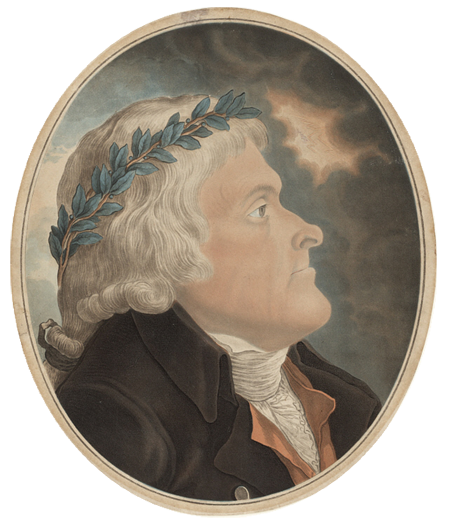 When America’s first non-Federalist executive, Thomas Jefferson, took office to become the third president in March, 1801, the party of Washington and Hamilton was on the ropes.
When America’s first non-Federalist executive, Thomas Jefferson, took office to become the third president in March, 1801, the party of Washington and Hamilton was on the ropes.
And over the next several years, Federalists’ blood ran cold as they witnessed Jefferson entrenching his political viewpoint in every way conceivable. High-toned, elite New Englanders (or “Nov-Anglians” as some of them then said!) augured their own doom in the Louisiana Purchase and in the Twelfth Amendment.
Then came Jefferson’s power grab into the judicial branch.
When it came to exercising the impeachment power, that grab began, but did not end with, John Pickering.
Pickering was a Federalist U.S. District Court judge in New Hampshire. His gold-quality resume included military service in the Revolutionary War and drafting New Hampshire’s state constitution (the Granite State being, audaciously, the first of all the former British colonies to write its own constitution).
But by the time Jefferson had come to power, Pickering—like not a few of his generation—was heading at a rapid clip towards decrepitude. The judge had degenerated into alcoholism and mental derangement. In other words, the man was incompetent and, by all accounts, insane.
Yet, the Federalists were desperate to hang onto Pickering.
After all, were Pickering to retire, resign, or pass away, Jefferson would naturally appoint a Democratic-Republican to take his place. The Federalists had already lost the presidency. And Congress. The judicial branch was their only remaining bulwark. Yielding any more power to their political rivals would be the pits.
Jefferson, however, wanted Pickering out. And a “party man” in.
In fact, Jefferson personally initiated the impeachment proceedings. He did so with a message to the House of Representatives. (Under Article I of the Constitution, the House has the sole power to impeach a federal officer).
The House’s Democratic-Republican majority did not require much prompting to take Jefferson’s cue. They began the impeachment process. They drafted a four-part Articles of Impeachment for Pickering and delivered it to the Senate. The Senate—intended to be the more refined, conservative, far-sighted, and responsible body of Congress—would exercise its Constitutional power to conduct Pickering’s impeachment trial.
If found guilty, the Senate, and only the Senate, could remove Pickering from office.
For Democratic-Republicans to furnish Jefferson with the result he was spoiling for, what exactly would they have to prove?
Article II, Section 4 spells out that:
Unfortunately for Jefferson, there were no treason or bribery cases to make against Pickering. He had done nothing against the law. There was no offense to indict against a particular statute. That left Jefferson and the Democratic-Republicans with only one other option:
“Other high crimes and misdemeanors.”
But what exactly are “high crimes and misdemeanors?” On its face, the former expression (“high crimes”) is far more serious than the latter (“misdemeanors.”)
This is one of the Constitution’s many “terms of art:” those catch-all phrases that reflect areas where the mighty power of language utterly breaks down.
No conceived earthly dialect has the power to succinctly specify all things that might fall within these certain Constitutional categories. So we are left with a kind of unsatisfying generalization that, nevertheless, we need to somehow make work.
“Keep and bear arms,” “cruel and unusual punishments,” “necessary and proper”—these are all similar terms of art that tend to lead to tedious and digressive debates about their meaning. And like a witch’s curse that just can’t be dispelled, they keep coming back to beguile us.
“High crimes and misdemeanors” is an especially problematic phrase. What is a “high” crime? The language of the Constitution intentionally places the term “misdemeanor” in the plural. Does that mean that those lesser infringements must be multiple in number? And how does the word “and” operate here? Does it imply or necessitate that crimes as well as misdemeanors must have been committed in combination? Is impeachment possible for just one high crime? What about two high crimes and one misdemeanor?
The Founders left us with this disheartening problem because they foresaw an intrinsic flaw with the impeachment power.
Namely, the danger that impeachment could be used to remove duly elected or appointed officers simply for political reasons—because they hold unpopular beliefs, or take unpopular action.
In the Constitutional debates in 1787, a “maladministration” standard was floated for impeachment. To put that another way, the Founding Fathers debated whether or not an unsatisfying performance in a given in a U.S. government office of trust should be grounds for impeachment.
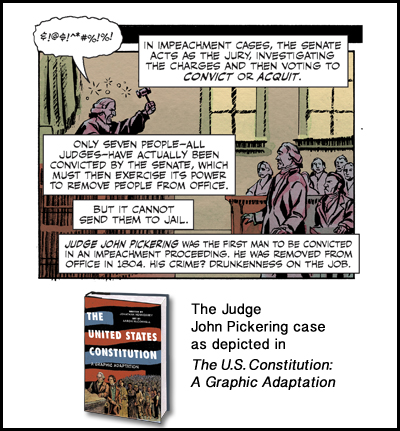 Ultimately this was decided against. Wiser minds understood that “maladministration” is a charge too closely tied to opinion. One person’s “maladministration” could easily be another man’s highly principled reason for voting a certain way on a certain bill, or pardoning a notorious criminal, or signing a widely condemned international treaty. The Founders wanted both to give the people a chance to communicate displeasure with their leaders but also shield those leaders from popular or partisan “witch hunts.”
Ultimately this was decided against. Wiser minds understood that “maladministration” is a charge too closely tied to opinion. One person’s “maladministration” could easily be another man’s highly principled reason for voting a certain way on a certain bill, or pardoning a notorious criminal, or signing a widely condemned international treaty. The Founders wanted both to give the people a chance to communicate displeasure with their leaders but also shield those leaders from popular or partisan “witch hunts.”
In The Federalist #65, Hamilton attempts to clarify “high crimes and misdemeanors” by describing impeachable offenses as “the abuse or violation of some public trust” and immediately injurious to “society itself.” This might fairly be called heaping more terms of art upon other terms of art. The legal definition of “abuse” is open to debate, as is “immediately injurious.” Again, it comes down to the insufficiency of language.
Returning to Pickering, and in defense of Jefferson and the Democratic-Republicans, the man was clearly unfit for office.
But in what must be described as a flaw or oversight in the Constitution, there is no legal method to remove a president, vice president, or civil officer for reasons of incompetence, substance addiction, or insanity (unless that incompetence or insanity leads to an indictable legal offense).
So, again, that left Jefferson’s party with the challenge of taking Pickering’s condition and constructing a case that it amounted to “high crimes and misdemeanors.”
Given that they were acting largely from political motivations, it turns out that they did not quibble much over the meaning of “high crimes and misdemeanors.” No. The faction that staked a claim to “strict constructionism” and narrow interpretation of the Constitution were just fine to be extraordinarily broad and permissive with Article II, Section 4. Especially in Part 4 of the Articles of Impeachment against Pickering:
So in review, the precedent set by America’s very first impeachment trial included:
- “Loose morals and intemperate habits”
- Public intoxication
- Infringement of the Biblical Third Commandment
- Generally behaving in such a way as to be “degrading to the honor and dignity of the United States.”
Now remember, these Articles of Impeachment were drafted and sent up the chain of command by the House. How did it play in the Senate? The august body with the actual power to remove Pickering from office?
The Senate (with a total membership in 1803 of 34) voted 20-6 in favor of removing Pickering from office.
Two Federalist Senators were present but refused to vote. In additional protest and/or discomfort over the fast and loose play with the Constitution, three additional Senators did not show up for work that day. They did not vote at all.
Jefferson had scored. And in fact he replaced Pickering with the Democratic-Republican district attorney of New Hampshire John Samuel Sherburne, who had also acted as a witness against Pickering in the impeachment trial. This is an additional and quite flagrant conflict of interest.
Thus emboldened Jefferson did not stop with Pickering. He went on to try to bring down another Federalist judge, this time Samuel Chase, a Supreme Court of the United States justice. The Democratic-Republicans did not fare as well in that case. But through impeachment and other means (like refusing to deliver a commission in the famous Marbury v. Madison case), Jefferson by one count succeeded in removing eighteen of thirty Federalist judges between 1801 and 1803.
What should be our takeaway from all this?
First, whenever a politician or a politician’s camp raises a hue and cry about a “partisan witch hunt,” remember that those are nearly as old as the republic itself. And had no better endorsement than the lofty states’ rightist/small government man Thomas Jefferson.
And if “loose morals and intemperate habits” as well as conduct “degrading to the honor and dignity of the United States” sounds like any high civil officer you can think of these days, remember that American history is standing by to provide a sound precedent for what form “high crimes and misdemeanors” can take.

